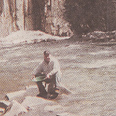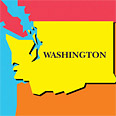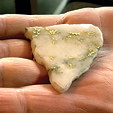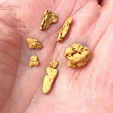All Articles
Legislative and Regulatory Update
May 2002 by Staff
• Occupancy rules discussedOccupancy is covered under the Use and Occupancy sections of the Code of Federal Regulations (CFRs). Specific sections related to Occupancy begin at 43 CFR 3715.1.
The majority of patented claims include both the surface and mineral rights. We will address unpatented claims here, because unpatented claims don’t include surface rights.
You are allowed to occupy your claim for 14 days or less in any 90-day period as long as your occupancy is reasonably incident to mining. This 14-day limit within a 90-day period applies to all of your claims within a 25-mile radius. If you are not going to exceed the 14-day limit, then you don’t need to notify BLM that you are occupying your claim.
However, if your work will involve the placement of structures, gates, or signs meant to prohibit the public from entry, then you must consult with BLM even if your stay is 14 days or less.
You don’t have to be working constantly from dusk to dawn, but claims are not private camping resorts. Equipment must be present and operable, although reasonable repairs, assembly, and maintenance is allowed.
For occupancy over 14 days, or if structures, gates, or signs intended to exclude the public are going to be used, you need to consult with BLM. Even activities that fall under “casual use” require a consultation if you are going to exceed the 14-day limit on occupancy. If you are staying at a nearby campground or hotel, then you are not occupying your claim and you should not have to worry about the 14-day limit.
You can request extended occupancy for one or more of the following reasons:
a) to protect exposed, concentrated or otherwise accessible valuable minerals from theft or loss. This would not apply to minerals still in the ground or buried under cobbles at the bottom of a river.
b) to protect appropriate, operable equipment from theft or loss, which is regularly used and not readily portable, and cannot be reasonably protected by other means.
c) to protect the public from the equipment mentioned above if such equipment would create a hazard to the public if left unattended.
d) to protect the public from surface uses, workings, or improvements, which would create a hazard to the public if left unattended.
e) if the claim is so remote that you would be unable to work a full shift (8 hours) if you were required to travel to and from the claim each day.
You can also request occupancy for a caretaker or watchman if your situation is described above and the work is reasonably incident to mining and continual.
BLM may allow you to temporarily occupy a site for more than 14 days if you have begun consultation with BLM for one of the above reasons.
The majority of miners who request occupancy are operating under a Notice or Plan of Operation. Information to support occupancy must be included with the original Notice or Plan, or in amendment to the Notice or Plan.
BLM requires the following information when reviewing occupancy requests:
a) how the proposed occupancy is reasonably incident.
b) how the proposed occupancy meets at least one of the previously mentioned conditions.
c) where temporary or permanent structures will be placed.
d) the location(s) and reason for enclosures, fences, gates, or signs meant to exclude the general public.
e) the location(s) or access routes that can be reasonably used by the public to access adjacent public lands.
f) the estimated period of use for the structures, enclosures, fences, gates, and signs, including the estimated schedule for removal and reclamation.
A detailed map shall be included that identifies the site and indicates the placement of these items.
BLM has 30 days to respond to your request for occupancy unless they determine that environmental studies are necessary.
• Comment period open for small-scale mining and dredging in Oregon
Oregon’s Department of Environmental Quality (DEQ) has issued two separate Draft Mutual Agreement Orders (MAOs) to address small-scale mining and suction dredging. The previous general permits, issued by the Water Pollution Control Facilities (WPCF), expired in February and March 2002. DEQ intends to postpone renewal of the general permits and initiate discussions with the Oregon Dept. of Geology and Mineral Industries and the federal land agencies with the stated goal of reducing duplication of efforts.
Small-scale mining. The MAO for small-scale mining will apply to the following metal mining and/or ore processing operations where all wastewater is disposed of by evaporation and/or seepage, with no readily-traceable discharge to groundwater or surface water:
a) off-stream placer mining
b) hardrock mining and/or ore processing that uses non-chemical ore processing methods and processes no more than 10,000 cubic yards of material per year.
Other conditions for small-scale mining include:
a) Miners must utilize or dispose of all settling pond spoils and other waste solids in a manner which will prevent their entry into surface water and avoid creation of nuisance conditions and/or water quality violations.
b) Miners shall provide for safe passage of fish around or through the active mining area if the stream supports an anadromous fish population. Any construction within the active stream, including construction of fish passage facilities, shall meet the requirements of the Division of State Lands (DSL).
c) Miners shall observe and inspect all waste handling, treatment, and disposal facilities and any stream above and below the mining operation daily when operating, to ensure compliance with the conditions of the MAO. Miners shall keep a record of these observations until terminating the MAO or the MAO expires, and shall make the records available to DEQ upon request.
d) Miners must obtain DEQ’s approval prior to construction or modification of any wastewater control facility. Small sedimentation ponds with a surface area of 20,000 feet or less are exempt from this requirement provided dikes are no more than 5 feet in height.
e) Miners must dispose of sanitary wastes into a septic tank and drainfield or other approved means which is installed, operated, and maintained in accordance with the requirements of DEQ and/or the local health department. Miners must acquire any necessary site evaluations and permits prior to construction.
f) Miners must not conduct any placer mining on federal lands located within the Oregon Scenic Waterways except as allowed by agencies of the federal government. Placer mining in the Oregon Scenic Waterways must follow the regulations and requirements of the Oregon Parks and Recreation Dept., the DSL, and the Oregon Water Resources Dept.
g) Miners must obtain a Removal-Fill Permit for any placer mining operation that involves an alteration, removal, or filling of more than 50 cubic yards of material per year in any waterway. A Removal-Fill Permit may be required by the DSL for a small placer mining operation involving less than fifty cubic yards per year.
h) Miners may not undercut riparian vegetation and should not disturb it whenever practicable. In areas where riparian vegetation is disturbed, the miner shall revegetate each disturbed area prior to concluding mining activities. Revegetation must be done on an on-going basis.
There are other related rules that have been proposed. Dredgers should go online to www.deq.state.or.us or visit their regional DEQ office to read the entire document. A direct link to this document is available on our home page at www.icmj.com.
Dredging. The major proposed rules for dredging are as follows:
a) Miners must not dredge outside the active stream channel or where the dredging spoils are not relatively clean. Miners must not mine stream banks (highbanking) or upland areas.
b) Miners must minimize in-stream turbidity and ensure that the turbidity is localized to the general area of the dredging activity. If turbidity is visible 300 feet downstream from one or more working suction dredges, then turbidity exceeds allowable instream water quality standards, and dredging must be stopped. Miners must not discharge tailings into any naturally occurring pool in the work area if it will reduce the volume or depth of the pool.
Other conditions related to dredging include:
a) Miners must not cause harassment of fish in the stream, nor conduct dredging during the periods when fish may be in the gravel at the dredge site. Miners must follow Oregon Dept. of Fish & Wildlife (ODFW) Guidelines for Timing of In-Water Work.
b) Miners must not allow spillage into surface waters or to groundwater during refueling of the dredge. Miners
must check for fuel or oil leaks prior to starting. Disposal of fuel or oil at the site is not allowed.
c) Miners may not remove or disturb rooted or embedded woody plants in the stream. This includes living trees and shrubs, and woody material that is less than the width of the stream channel bed.
d) Miners may not conduct dredging in a manner that undercuts stream banks or riparian vegetation.
e) Miners must provide for safe passage of fish around and through the mining area if the stream supports anadromous fish.
f) Miners must not conduct dredging in a manner that results in the formation of a dam within the stream or divert a waterway, and check dams are not allowed.
g) Miners must not cause channel alterations, including those needed to accommodate suction dredging during low stream flows that result in a wider wet perimeter or shallower water depth than pre-mining conditions. After completion of the mining activity, miners must remove the channel alteration and restore the stream channel such that stream flows will not be restricted, obstructed or rechanneled when higher flows return.
h) A copy of the MOA must be readily available at the dredging site during dredging activities.
i) Miners may not conduct dredging in streams designated by the DEQ as water quality limited for dissolved oxygen during any period of anadromous fish rearing or spawning through fry emergence as identified by the ODFW.
j) Miners may not conduct dredging in any streams designated as water quality limited for turbidity or toxics.
k) Oregon Scenic Waterways and Essential Salmon Habitat Streams are restricted to dredges with 4” intakes and motors with 16 horsepower.
l) An additional permit from DSL is required for Oregon Scenic Waterways and Essential Salmon Habitat. Regulations and requirements of the Oregon Parks & Recreation Dept., the DSL, and the Oregon Water Resources Dept. apply in these areas. Dredging within 1/4 mile of a Oregon Scenic Waterway corridor may require notification of Oregon State Parks.
m) Dredging on federal lands is allowed if okay under federal rules.
n) A Notice or Plan is required if dredging beyond the wetted perimeter.
There are other related rules that have been proposed. Dredgers should go online to www.deq.state.or.us or visit their regional DEQ office to read the entire document. A direct link to this document is available on our home page at www.icmj.com.
Hearings on these draft MAO’s will be held as follows:
May 14, 2002—
Baker City School District Offices
2090 4th St.
North Conference Room
Baker City, Oregon
May 26, 2002—
Josephine County BBC
Anne G. Basker Auditorium
604 NW Sixth St.
Grants Pass, Oregon
Written comments are due by 5pm on May 21, 2002. Comments can be sent via one of the following methods:
Mail:
James Cowan
DEQ Water Quality Division
811 SW 6th Ave.
Portland, OR 97204
Email:
cowan.james@deq.state.or.us
Fax:
(503) 229-5408

The Colorado Mineral Belt
 The 250 mile long Colorado Mineral Belt cuts diagonally across central and southwestern Colorado, in the heart of the Rocky Mountains...
The 250 mile long Colorado Mineral Belt cuts diagonally across central and southwestern Colorado, in the heart of the Rocky Mountains...
Mining Stock Quotes and Mineral & Metal Prices
Progress Report on Washington State Small-Scale Regulations
 Washington State has some of the most far-reaching, restrictive and overzealous regulations in the United States regarding small-scale prospecting and mining. Take one look at the “Gold and Fish” book, which lays out regulations for...
Washington State has some of the most far-reaching, restrictive and overzealous regulations in the United States regarding small-scale prospecting and mining. Take one look at the “Gold and Fish” book, which lays out regulations for...
Sixteen to One Gold Mine: Unique Challenges and Potential Rewards - Pt I
 Many of the Sixteen to One’s challenges arise from its unusual geology and the pocket characteristics of the ore deposits.
Many of the Sixteen to One’s challenges arise from its unusual geology and the pocket characteristics of the ore deposits.
It's Another 'Ben Day'
 I looked over and saw Ben on his knees, digging at the edge of the Manzanitas, almost underneath them. I thought back to the previous weekend when we were planning this trip—that day had been a “Ben day.”
I looked over and saw Ben on his knees, digging at the edge of the Manzanitas, almost underneath them. I thought back to the previous weekend when we were planning this trip—that day had been a “Ben day.”
Proper Spacing of Placer Sample Sites
The zone of influence of each sample must be carefully considered when deciding how far sample sites should be spaced from each other.
Melman on Gold & Silver
The ultimate resolution of this apparent contradiction between fundamental news and market performance could provide us with important future clues for gold and silver.
Subscription Required:
The Bawl Mill
• Our Readers Say
• California Wilderness Coalition and The Nature Conservancy Recruit Government Employees to Carry Out Huge Land Grab
• Drywashing Rules Clarified
• Mineralized Calderas in Colorado
• The Keystone Gold-Copper District, Medicine Bow Mountains, Southeastern Wyoming
• Picks & Pans: Mining Tungsten Ore—A Case History
• Gold in Oregon
• Aussie Gold—A Look at the Northern Territory
• The Phoenix Gold Mine: A Brief History
• Calico Mine
• Mining Stock Quotes and Mineral & Metal Prices
• Looking Back
• Melman on Gold & Silver
Free:








